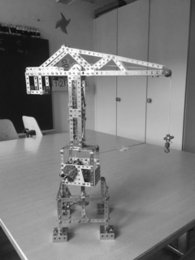“I am so bored ...”
by Dr Eliane Perret, curative teacher and psychologist
Mothers and fathers are bound to hear this phrase often in these days and weeks. Fortunately, very few will simply park their children in front of the TV or let them game for hours to get some peace and quiet. The result would be that the children would end their day with inner emptiness and in a bad mood, increasingly developing addictive behaviour. But what to do? A child’s whining that he or she is bored needs not be an invitation for the parents to organise an entertainment programme on the spot. Boredom can be creative and an occasion to pick up the coloured pencils and drawing paper again, to fold a hat or a boat out of a newspaper, to organise a competition with paper planes. Almost everyone has printer paper available. But older siblings or adults are wanted to help getting started. If corresponding books are not available, instructions can be found in large numbers on the internet.
How did that go?
Maybe some mothers and fathers start to remember rainy afternoons with their siblings, parents or grandparents. It may be worthwhile! There have been afternoons playing together, where we would learn playing cards or, where adults were hopelessly loss while playing “Pairs” against their children who always managed to pick the right pairs of cards. Surely many families have many games like this available, maybe a bit deeper in the cabinet, displaced by computers, Nintendo, Play Station or corresponding mobile phone apps in the past years.
Not a lot of equipment needed
In a household there are many materials which help passing the time together. The word “TOGETHER” should be written in capital letters here. Do you remember the drawing game where everyone gets a strip of paper? Everyone draws a head at the top of the paper, hiding it from the others, then folds the paper over and passes it on to the next person, who then “unsuspectingly” adds their body and arms before folding it over again and passing it on. The last one completes the drawing with legs and feet. Now the resulting drawings are inspected. Everybody will be happy about the funny figures thus created. There are many more similar games, for which all you need is a sheet of paper and a pencil.
In our school camps we play “All birds fly high” over and over. The game leader says: “All birds fly high”, lifting his hands and “flying” with them. The others do the same. Then he shouts for example: “All mosquitoes fly high”, all butterflies, parrots etc. But can an elephant fly up? When the game master shouts this out and puts his hands in the air, the others should keep their hands on the table. Whoever falls in gives a forfeit which can be released again later with fun tasks. There are many games like this. Maybe also a reason to order a corresponding book from your personal bookstore. But grandparents would also know a few things and could act as coaches, keeping in touch by phone is possible and the post office is still working.
Playing together is the trend!
Playing together or independently not only dispels boredom. The children are practicing many abilities: they can train their memory, practise strategic thinking and they have to learn to deal with their feelings, to be happy about victories, but also to accept defeat with a certain degree of composure. In technical jargon one speaks of “executive functions” that are trained in the process: working memory, inhibition (impulse control) and cognitive flexibility (adapting to new situations). In other words, playing not only dispels boredom but also deepens the child‘s skills needed for learning and personal development. Obviously, many children lack them. Accordingly, the Children’s Hospital St. Gallen, for example, has been offering play afternoons for some time now where educators get to know a variety of children‘s games that they can use at home, in day-care centres or even in schools. So: Playing together is the trend!
Where are the Lego pieces?
In some children’s rooms, or perhaps already in the attic, there is still a box with the colourful Lego blocks, Matador, Duplo etc. A child can stay there alone and practice creativity, spatial imagination and patience. With the appropriate echo from the others, they will deepen further. So it does not always take adults to “help” the bored child. He or she learns a lot when staying on something. Especially with simple handicrafts, children often develop an undreamt-of enthusiasm, e.g. producing paper animals in great numbers etc., becoming more and more skilful in the process …
For the older ones, there are also metal construction kits allowing to assemble helicopters, cable cars, etc., while practicing e.g. to use screwdrivers. Who knows, maybe a career wish will be born there? The corresponding Swiss product is called Stokys and is now again being produced in Tösstal for several years. Incidentally, it was developed during the Second World War as an alternative to Meccano, which was no longer supplied to Switzerland. It was the last time that Switzerland was under emergency law!
Cutting, gluing and building
Maybe you still remember: In the time before Christmas, children and young people were allowed to order model sheets. Some of them put together a Christmas lantern, the zoo, a small village, a farmhouse, a castle or chateau – and were very challenged with the Kyburg or the Chillon Castle. Our pupils learn to work with these model sheets in handicraft lessons, and most of them enjoy doing it: understanding the instructions, cutting correctly, creasing (also works with a knitting needle) and gluing together according to plan. Yes, these model sheets still exist. Another good occupation for boring times, and not only for the children.
Organising the household together
Of course, everyday life for children cannot only be playing games. Schools have now organised learning programmes for the children. For all the variety and use of digital possibilities: the most important thing is building a relationship, which must not be neglected.
But the household must also be managed. After all, everyone is hungry, the apartment needs cleaning, flowers need watering and much more. If everyone participates, it is not only faster. It is also more fun, gives the feeling of being needed, and you learn to work together as a team. This way the day can be well structured: studying, housekeeping, playing and a limited screen time. This is important not only for the children, but for the whole family. It gives everyone the support they need.
Behaviour is important
Our Federal Council emphasises the inner attitude and our behaviour in view of the dangerous situation we are facing. Solidarity must not just be a slogan for 1st August [the Swiss National Holiday], he said. That is correct and now it is also the order of the day in our families! This includes that everyone is contributing, cooperating and learning from the others also in challenging times. •
1 Dürr, Gisela; Stiefenhofer, Martin. Schöne alte Kinderspiele. Ideen für Kinder aller Altersstufen. Verlag Bassermann. ISBN 978-3-8094-2752-0
Stöcklin-Meier, Susanne. Spielen, Bewegen, Selbermachen … und zusammen lachen. Verlag Atlantis. ISBN 978-3-7152-1059-9
2 http://www.kinderkliniken.insel.ch/de/kinderkliniken/kinderheilkunde/neuropaediatrie/neuro-angebot0/spielliste/
3 source of supply for Stokys: www.stokys.ch, phone: +41 52 233 00 15 (Mo–Fr 08.30–12.00 and 13.30–17.00), E-Mail: kontakt@stokys.ch
4 source of supply for model airplanes: Stiftung Pädagogischer Verlag der Lehrerinnen und Lehrer Zürich. Online-Shop: www.paedag.ch

